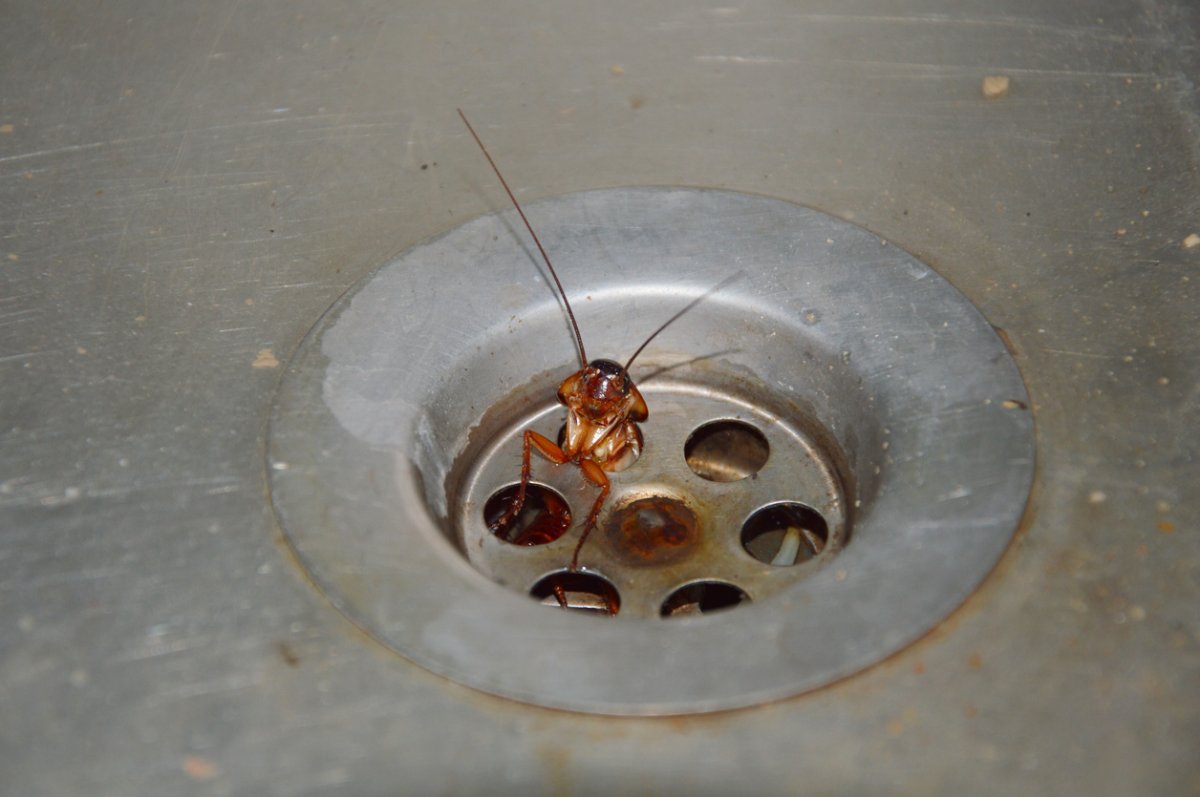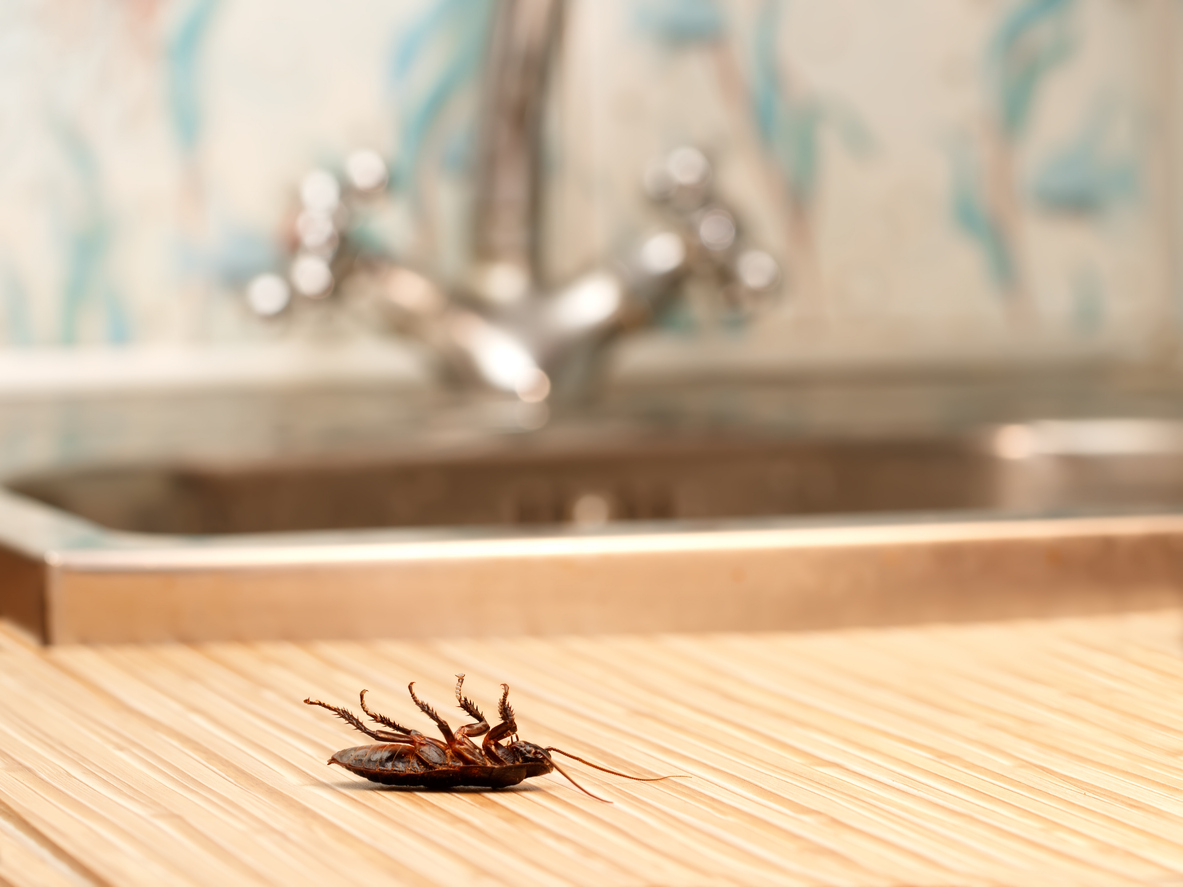

We may earn revenue from the products available on this page and participate in affiliate programs. Learn More ›
What You Need to Know
- Roaches come up drains seeking water and food, but they don’t typically nest within pipes.
- Most substances that are commonly poured down drains to kill roaches are actually ineffective or unsafe.
- Alternative solutions for getting rid of roaches in drains include installing drain covers, sealing cracks in and around plumbing fixtures, eliminating plumbing leaks, and keeping drains and countertops clean and dry.
- The most effective way to get rid of cockroaches is to hire one of the best cockroach exterminators (like Orkin or Terminix).
Q: Yikes! I’ve just spotted a cockroach in my kitchen sink and I’m worried there may be more of them. Is there anything I can pour down the drain to kill roaches?
A: Finding insects coming out of the drain is unsettling—especially when the experience is followed by the thought of more unwanted pests crawling through the plumbing system. The debris that accumulates in a drain as well as the dark and sheltered environment creates an ideal breeding ground for sewer cockroaches to thrive and lay their eggs.
A common first instinct might be to reach for bleach for cockroaches. However, many experts advise against pouring bleach down the drain. “It is never advisable to pour any chemicals down any drain,” says Stewart Muir, a safety and technical manager and associate certified entomologist at JP McHale Pest Management in Buchanan, New York. “Most pesticides are not labeled for drains; any pesticides or other chemicals can damage pipes and drains. Plus, on an environmental level, we do not want pesticides reaching any possible water sources.”
In fact, most remedies recommended to pour down the drain to kill roaches are ineffective or downright unsafe. Still, it’s important to get rid of cockroaches, as these pests have the potential to carry disease and allergens into the home if left unchecked. Fortunately, there are plenty of alternatives for getting rid of cockroaches in drain pipes for good—whether it’s a DIY solution or calling an exterminator.
4 Common DIY Solutions That Don’t Actually Work
Those searching online for suggestions of what to pour down the drain to kill roaches will find dozens of recommendations from bleach, boiling water, chemical pesticides, and more. Some of these remedies may indeed kill roaches. However, incorrect application of DIY pest control remedies and chemicals in drains can pose significant risks to a building’s plumbing system and the household environment.
“The unknowing user may put caustic materials down the drain, causing damage to the plumbing system itself,” says Shannon Harlow-Ellis, associate certified entomologist and technical services manager at Mosquito Joe, a pest control company with franchise locations across the U.S. “Moreover, there is the potential to create toxic fumes if you mix cleansers with pesticide products.”
There are also broader environmental consequences of pouring toxic chemicals down the drain.
Craig Sansig is a service director, associate certified entomologist (ACE), and public health entomology (PHE) certificate holder at Viking Pest Control in Liberty Corner, New Jersey. According to him, “Sewage treatment plants are designed to treat and remove sewage, not chemicals. Pesticides poured in drains will therefore end up in undesirable locations like streams, lakes, and rivers where treated water is released. Improperly applied or disposed of pesticides may have devastating impacts on these sensitive environments.”
Most of these methods also do not address the root cause of the infestation and can temporarily push sewer roaches deeper into the plumbing or other areas of the home. These substances are often used to try to kill roaches in drains, but they are not ideal:
- Baking soda and vinegar: The combination causes a bubbling reaction, which might seem effective for pest control. However, it lacks the potency to kill roaches, and it may only disturb them temporarily without solving the infestation problem.
- Boiling water: Boiling water can cause damage to PVC pipes and the glue holding pipe joints together, which can lead to expensive plumbing repair costs. Also, by the time the water reaches deep enough into the pipe to reach roaches, it will no longer be hot enough to harm them.
- Bleach: Although bleach is a strong chemical that can kill roaches on contact, it is hazardous and can release harmful fumes. Additionally, pouring bleach down the drain can corrode pipes, especially when used repeatedly or in high concentrations.
- Pesticides: Pouring pesticides down the drain is ineffective for roaches hidden deep within plumbing systems and poses severe environmental risks. The Environmental Protection Agency (EPA) strongly advises against pouring pesticides into drains, as wastewater treatment systems can’t remove all pesticide residue. This can lead to potential contamination of waterways.

5 Alternative Methods for Keeping Roaches Out of Drains
While some DIY pest solutions can be effective in the short term, it’s a good idea to tackle the root of the problem rather than resorting to potentially damaging quick fixes. A few proactive strategies can deter cockroaches and enhance overall household hygiene.
Install drain covers to block cockroaches from emerging from the drain.
Installing drain covers is a simple yet highly effective method to prevent the emergence of cockroaches from drains. Drain covers act as physical barriers that block access but still allow water to pass through. These covers are available in stainless steel, silicone, and plastic materials and can be fitted over the drain opening to prevent roaches and other pests from climbing out and into the home.
For optimal protection, it’s important to ensure that the drain cover fits snugly and leaves no gaps around the edges where roaches could potentially enter. Drain covers that have fine mesh screens are crucial for blocking the entry of pests while minimizing the risk of clogging by catching food debris.
For drains that are not standard sizes or shapes, custom solutions can be provided by professionals. Regular cleaning and maintenance of these covers is also essential to ensure they remain effective.
Seal cracks and gaps in and around drain pipes to prevent cockroaches from entering the plumbing system.
Structural issues in plumbing, such as cracks and leaks, can attract the entry of roaches into drain pipes. These gaps provide easy access points for roaches seeking new sources of water and food. The plumbing system’s network allows cockroaches in drains to move freely between different areas of a building, so infestations can spread quickly. “Keep all cracks and crevices around plumbing lines, drains, windows, and doors sealed with the appropriate caulking materials,” advises Harlow-Ellis. “This will help prevent…cockroaches [from accessing] the inside of your home.”
It’s wise to schedule regular inspections of all plumbing fixtures, particularly under sinks, around bathtubs, and near any water utilities, to identify potential entry points. In addition to visible cracks in plumbing, it’s important to ensure the areas where pipes enter walls are thoroughly sealed, too. While there will be a plumbing inspection fee if you hire a professional, this step can prevent a more severe (and more costly) pest or plumbing issue in the future.
Identify and repair plumbing leaks to reduce excess moisture.
A diligent approach to reducing excess moisture is crucial for deterring cockroaches. Plumbing leaks are a common source of unnecessary moisture, and minor drips can create an ideal habitat for roaches. It’s important to monitor plumbing fixtures, including pipes, faucets, and under-sink areas, for leaks.
“German cockroaches, which are one of the most encountered cockroach species, [are] highly dependent on moisture to survive,” says Sansig. “Correcting leaks and removing sources of moisture will help to create unfavorable harborage conditions for cockroaches.”
When fixing leaks, replacing old washers and seals can often solve the problem; however, more significant issues may require the work of one of the best plumbing services (some top choices are Mr. Rooter or Roto-Rooter).
It’s also important to combat moisture levels with dehumidifiers in damp areas of the home such as basements or bathrooms. Good ventilation throughout the home can further help maintain a dry environment that’s inhospitable for roaches.
Eliminate odors that attract roaches by keeping drains and countertops clean and dry.
Whether you’re trying to get rid of roaches in kitchen cabinets, drains, or elsewhere, Muir says that “keeping your home as clean as possible will remove many food sources for roaches. Taking out the garbage regularly, doing dishes in the evening, and sealing all other food sources in plastic or glass containers will allow any baiting treatments to work much more efficiently.”
Regularly cleaning drains and countertops will remove residue and neutralize the odors that attract pests. Free-flowing drains can be achieved with the help of enzymatic cleaners that break down organic clogs without the harsh chemicals found in traditional drain cleaners. For severe clogs, it’s worth hiring one of the best drain cleaning services.
Consider hiring a pest control service.
When utilized correctly, home roach traps or one of the best DIY pest control programs may be effective for minor infestations. However, getting help from one of the best pest control companies is often the safest and most effective way to eliminate an existing roach infestation in drains. “Homeowners should reach out to a pest professional as soon as they see any evidence of [roaches] in their home,” Muir advises. “Their ability to reproduce quickly gives you a small window of time to keep their numbers at a minimum.”
Unlike DIY methods, professional exterminators use the best insecticides and methods tailored specifically to the situation to ensure the treatment reaches deep into the plumbing where roaches hide and breed.
Finally, professional pest control services can guarantee that the methods used are both effective against cockroaches and safe for the home’s human and animal occupants.
“Professionals have access to a wide assortment of control materials and specialized application tools that would otherwise be inaccessible to the average homeowner,” explains Sansig. “These tools and materials enable us to utilize multiple control strategies to maximize effectiveness while reducing exposure to homeowners.”
